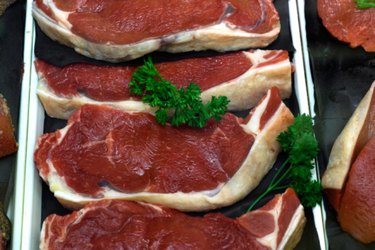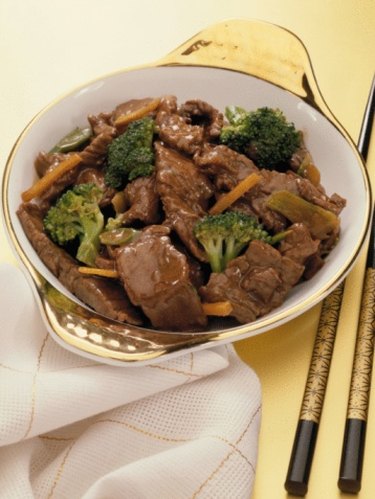
When shoppers patronized a butcher shop years ago, the butcher educated his customers in the meat that filled his cases; the shopper could even ask about how to cook her purchase. Although the knowledgeable butcher still practices in shops and groceries, high-volume markets provide pre-packaged, labeled and dated meats with labels that promise economy and convenience but don't offer much information.
Beef 101
Video of the Day
Retailers, be they butchers or mega-food stores, purchase whole steers that are processed according to long-established patterns. The steaks and roasts that serve as centerpieces for cookouts and holiday dinners come from the center "top" of the animal -- the ribs and loin. Other more muscular parts contain less fat and provide brisket for corned beef, shoulder, chuck and rump roasts, beef riblets, organs, flank and round steaks. Even shanks and knuckles provide beef for creative cooks. Leftover trimmings may become stew meat and beef tips.
Video of the Day
Stew Beef

Beef tips may be used for stews but beef labeled "stew beef" is most often taken from the steer's neck, shoulder and shank; and from the breast plate, the source of short ribs, and back leg, or heel of round. Stew beef is less tender than other cuts because it is what is left over after the steaks and roasts have been cut. Meat labeled as beef tips should always show the source of the tips to ensure that they are not just stew meat which requires slow, moist heat for a tender result.
Types of Tips

The loin of the steer provides tips — tender trimmings that survive high heat and fast cooking. Tenderloin tips come from the long, most tender cut along the backbone at the top of the loins that also yields fillets. Tenderloin tips are trimmings taken when fillets are cut from the narrow part of the tenderloin or chateaubriand is taken from the end atop the sirloin. Sirloin tips are trimmed from the "tails" of sirloin steaks and roasts — the part of the cut that extends down over ribs. Tips may also come from tenderloin or sirloin roasts, cut and trimmed in triangular shapes. Tips not only contain more fat than stew beef, they are more flavorful.
Uses for Tips

Beef tips dredged in flour and browned or seared form the basis for company-worthy beef Stroganoff and beef Bourguignonne. Unlike stew beef, they are flavorful and require little seasoning. When tips are served over noodles or rice with pan dripping-based sauce, bread allows diners to sop up leftover sauce. Braised with teriyaki sauce and accompanied by cellophane noodles, they glisten in chafing dishes at a buffet dinner. Tips lend themselves to fast-cooking in sukiyaki, fondue and kabobs.